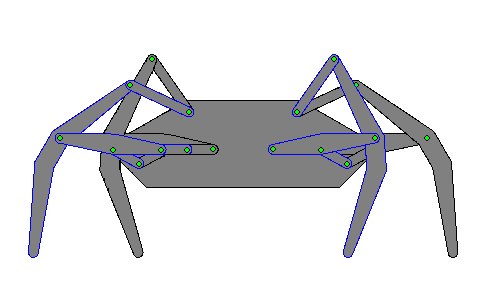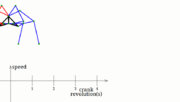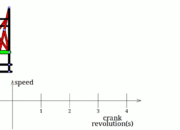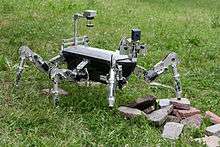Leg mechanism
A leg mechanism (walking mechanism) is an assembly of links and joints (a linkage) intended to simulate the walking motion of humans or animals. Mechanical legs can have one or more actuators, and can perform simple planar or complex motion.
Compared to a wheel, a leg mechanism is potentially better fitted to uneven terrain, as it can step over obstacles.[1]
Design goals
- vertical speed as constant as possible while touching the ground (support phase)[1][2]
- while the foot is not touching the ground, it should move as fast as possible
- constant torque/force input (or at least no extreme spikes/changes)
- stride height (enough for clearance, not too much to conserve energy)
- the foot has to touch the ground for at least half of the cycle for a two/four leg mechanism[1] or respectively, a third of the cycle for a three/six leg mechanism
- minimized moving mass
- vertical center of mass always inside the base of support[1]
- the speed of each leg or group of legs should be separately controllable for steering[2]
- the leg mechanism should allow forward and backward walking[2]
Another design goal can be, that stride height and length etc. can be controlled by the operator.[2] This can relatively easily be achieved with a hydraulic leg mechanism, but is not practicable with a crank-based leg mechanism.[2]
The optimization has to be done for the whole vehicle – ideally the force/torque variation during a rotation should cancel each other out.[1]
History
Richard Lovell Edgeworth tried in 1770 to construct a machine he called a "Wooden Horse", but was not successful.[3][4]
The Plantigrade Machine by Pafnuty Chebyshev was shown at the Exposition Universelle (1878).
Gallery
Stationary
-

Jansen linkage
-

Klann linkage
-

Eight-bar leg mechanism [1]
-

Tokyo Institute of Technology walking chair[2]
-

2 DOF pantograph leg mechanism[3]
-

2 DOF leg mechanism of the RPRPR type.[4]
-

Strandbeest (applied Jansen linkage)
-

Ghassaei Linkage[5]
-

Tchebyshevs plantigrade machine[6]
- ^ Simionescu, P.A.; Tempea, I. (20–24 June 1999). Kinematic and kinetostatic simulation of a leg mechanism (PDF). 10th World Congress on the Theory of Machines and Mechanisms. Oulu, Finland. pp. 572–577. Retrieved 27 July 2016.
- ^ Funabashi, H.; Takeda, Y.; Kawabuchi, I.; Higuchi, M. (20–24 June 1999). Development of a walking chair with a self-attitude-adjusting mechanism for stable walking on uneven terrain. 10th World Congress on the Theory of Machines and Mechanisms. Oulu, Finland. pp. 1164–1169.
- ^ Simionescu, P.A. (21–24 August 2016). MeKin2D: Suite for Planar Mechanism Kinematics. ASME 2016 Design Engineering Technical Conferences and Computers and Information in Engineering Conference. Charlotte, NC, USA. pp. 1–10.
- ^ Simionescu, P.A. (2014). Computer Aided Graphing and Simulation Tools for AutoCAD Users (1st ed.). Boca Raton, FL: CRC Press. ISBN 978-1-4822-5290-3.
- ^ Cite error: The named reference
ghassaeiwas invoked but never defined (see the help page). - ^ http://en.tcheb.ru/1
Walking
| * | 4 legs | 6 legs |
|---|---|---|
| Strandbeest |  |
 |
| Ghassaei |  |
 |
| Klann linkage 1 |  |
 |
| Klann linkage 2 |  |
|
| Plantigrade Mechanism |  |
Complex mechanism
Shown above are only planar mechanisms, but there are also more complex mechanism:
See also
- Jansen's linkage
- Kinematics
- Kinematic pairs
- Klann linkage
- Linkage (mechanical)
- Machine
- Mobile robot
- Hexapod (robotics)
References
- 1 2 3 4 5 Ghassaei, Amanda (20 April 2011). The Design and Optimization of a Crank-Based Leg Mechanism (PDF) (Thesis). Pomona College. Archived (PDF) from the original on 29 October 2013. Retrieved 27 July 2016.
- 1 2 3 4 5 Shigley, Joseph E. (September 1960). The Mechanics of Walking Vehicles: A Feasibility Study (PDF) (Report). University of Michigan Department of Mechanical Engineering. Archived from the original on 27 July 2016. Retrieved 27 July 2016.
- ↑ Giesbrecht, Daniel (8 April 2010). Design and optimization of a one-degree-of-freedom eight-bar leg mechanism for a walking machine (Thesis). University of Manitoba. Retrieved 27 July 2016.
- ↑ Uglow, Jenny (2002). The Lunar Men: Five Friends Whose Curiosity Changed the World. New York, New York: Farrar, Strauss and Giroux. ISBN 0-374-19440-8. Retrieved 27 July 2016.
External links
| Wikibooks has a book on the topic of: Comparison of crank based leg mechanism |


